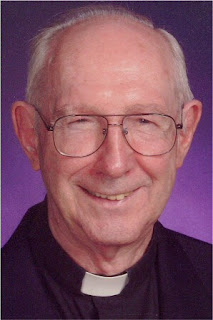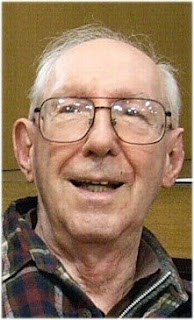
Professor Gerard Barry, S.J., has been a life-long friend of Professor John Nissel, S.J. and both, originally members of the Maryland Province of the Society of Jesus, worked together in the English Language Department of Sophia University. Although Prof. Barry was away from the Department for some years--while he founded and guided Sophia Junior College in Hadano--he returned to the Department and continued his teaching career with Prof. Nissel. Currently Fr. Barry is an assistant to the Pastor at St. Ignatius Church, the Jesuit Parish near Sophia. He was called upon to address the audience at the final parting celbrations for Fr. Nissel. Here, with his permission, are his words recalling the life and work of Fr. Nissel.
You can listen to Fr. Barry by starting the audio. For the convenience of Japanese visitors, about 70 seconds of Gospel Reading in Japanese precedes the English talk. If you prefer, skip the Japanese by moving the play button forward.(1)Windows Media Player
(2) Flash Player, for those who don't have Windows Media Player. Click the menu item 01 to start playing.

I will speak in English for several reasons. First, Fr. Doyle suggested that I do so. Second, a majority of those gathered here are graduates of the English Language Department, all former students of Fr Nissel, and because of his efforts you have mastered English. And finally, it makes my task much easier.Gerard Barry, S.J.
Fr. John Nissel was born on Oct 18, 1925; his mother, born Helen Sullivan, was of Irish descent, and his father, John Nissel, was of German descent. He went to parochial schools in Baltimore, St Benedict’s grade school and then on Loyola Jesuit High School. Upon graduation from Loyola HS he entered the Jesuit Novitiate at Wernersville, PA on 14 Aug, 1943. From Wernersville he moved to Woodstock College where he studied Philosophy from 1947 to 1950. In September 1950 he came to Japan and studied Japanese at Taura, Yokosuka, until July 1953. Then he returned to Woodstock again and studied Theology there until 1957. He was ordained priest on 17 June, 1956, at Woodstock. His last year of formation, tertianship, was spent at Auriesville, New York. From there he moved to Georgetown U where he earned a graduate degree in Linguistics. He returned to Japan in September 1959 and started teaching English Language in the newly established Faculty of Foreign Languages. He taught there for 32 years, until his retirement from Sophia U in 1992. During this period he held various positions in the University, Dean of the Faculty of Foreign Languages from 1967-1970, Dean of the International Division from 1971. In 1975 he taught English at the newly founded Sophia Junior College.
On retirement from Sophia he moved to Kagoshima, where he taught English language and literature at Kagoshima Junshin Junior College from 1992-2001. Then he moved to Rokko Catholic Church for pastoral work for a year. He returned to the SJ House in April 2002. Last year, 2008, he moved to Loyola House on November 11th.
Glimpses or vignettes into the boyhood of John Nissel
Catholic Boyhood
I caught a glimpse of his piety when Fr J’s sister Helen and his nephew Will visited Japan in May of last year. We went to Narita to pick them up and while riding back to Tokyo in the bus Will said that even though we had never met he felt he knew me. He certainly knew my name. I asked, “Why do you know my name?” It turns out that whenever the Dagenheart family said grace before meals, they would also ask God to help Jesuits working with Uncle Jack in Tokyo at Sophia. Will said we would pray for Fathers Forbes, Mason, Barry, McKeckney, etc. A litany of the names of those working with Fr Jack at Sophia. I was amazed and gratified to hear this. It gave me an insight into the piety that must have prevailed in the family of Fr Jack and his sister when they were children.
The second glimpse is related to Pimlico. The home of the Nissel family was near Pimlico, one of the more famous race tracks in the U.S. It was at Pimlico that on November 1, 1938, a race was held between Seabiscuit and War Admiral, two of the best race horses in the US. The race was called the "Match of the Century". It was one of the most anticipated sporting events in U.S. history. The Pimlico Race Course, from the grandstands to the infield, was jammed solid with fans. Trains were run from all over the country to bring fans to the race, and the estimated 40,000 at the track were joined by some 40 million listening on the radio. War Admiral was the prohibitive favorite (1-4 with most bookmakers) and a near unanimous selection of the writers and experts. Young Jack Nissel, then 13 years old, was not allowed inside the race track, but he did watch from outside the rails Seabiscuit’s stunning come from behind victory. He never forgot this and relished telling others about that day.
His character
Perhaps Fr N’s most productive work was done in the English Language Department. He was a member of the Department from its foundation and worked with Professors Noguchi, Koine, Forbes, Hattori, Mason, McKechney, Kishimura, Nakano, Graziano and others to establish and bring the Department to maturity. Besides his teaching duties, he always had some job in administration. Despite the endless rounds of meetings he always managed to have well prepared classes. What always amazed me was his popularity with his students. As an administrator he was strict and authoritarian. (He was the oldest child in his family.) But in the classroom he managed to have his students laugh several times during each session. As Professor Milward pointed out last night, he had an excellent sense of humor. Even after retirement he had a special rapport with younger Jesuits. He enjoyed teaching them English and they enjoyed his company.
Another characteristic he had was his quest for more effective teaching aids. Even before computers became popular he introduced into the English Language Department office things like the IBM Selectric Typewriter, classification using data or punch cards. When computers first came to Sophia he got one for the Department. We, any in the faculty who was interested, were introduced to Ichitaro, then TwinStar, then Word Perfect, etc. He also was instrumental in introducing Kurtzweil, the first scanner, to the department. He was instrumental in introducing the “reading card library” for student use in vocabulary building. He was always on the alert to find effective aids for teaching and administration. He was also quite zealous about keeping in touch with graduates of the department, for this reason he founded SELDAA, the journal of the English Language Department.
News of the death of Fr N came suddenly. He had entered Seibo Hospital on Saturday, January 24 and he died on January 25th. We were all shocked. When I heard the news the words Mark Van Doren said in his eulogy of Thomas Merton ran through my mind. Thomas Merton was orphaned at 16, at 23 he found Jesus Christ, at 26 he entered a Trappist monastery in Gethsemane, Kentucky. He died suddenly in 1969. Mark Van Doren said something like this at his funeral:
'The best bottle of wine
tipped over and spilled.
Catch it! Save it! But nobody could.
Now, nothing’s left but the fragrance.'
All we have left of Fr Jack Nissel now are our memories of him. These memories are like the fragrant smell coming from a fine wine. We are saddened by his absence, by the knowledge that we cannot see him again, we cannot be with him, enjoy his warm humor, see his friendly smile. But we are consoled by his faith.
He firmly believed in the words of today’s scripture. As Paul says in his letter to the Corinthians: (1 Cor 15: 51-57)
'The dead will be raised incorruptible, and we shall be changed. This corruptible body will be clothed with incorruptibility, this mortal body with immortality. When the corruptible frame takes on incorruptibility and the mortal immortality the saying of Scripture will be fulfilled; “Death is swallowed up in victory.” “O death, where is your victory? O death, where is your sting?” Thanks be to God who has given us victory through our Lord Jesus Christ.'
When faced with the death of a close friend the words of Hamlet may come to mind. In his “to be or not to be” speech Hamlet describes death as “the undiscovered country from whose bourn, (boundaries) no traveler returns.” This phrase well describes the finality of death. Once dead, no one returns to this earth. And this is scary. But the faith John Nissel had counterbalanced this fear. True, he did not display his faith; he did not “wear his faith on his sleeve” as we say. But his life was a testimony to his belief in the words of the Gospel we just read.
Jesus, at his last meeting with his beloved disciples, at the last supper, Jesus, knowing that he was soon to be arrested, tried, condemned to death, executed and buried, assured his followers:
'Do not let your hearts be troubled.
Have faith in God
and faith in me.
In my Father’s house there are many dwelling places;
otherwise, how could I have told you
that I was going to prepare a place for you?
I am indeed going to prepare a place for you,
and then I shall come back to take you with me,
that where I am you also may be.
You know the way that leads to where I go.' (John 14:1-4)
Yes, Lord, the life of John Nissel has helped us to understand your words more clearly. The memory of his life is our treasure and his gift to us.
Father Nissel: Thank you ever so much! You did so much for so many in such a gracious way. Till we meet again. Sayonara.
January 28, 2009. 13:30 St Ignatius Church, Tokyo






